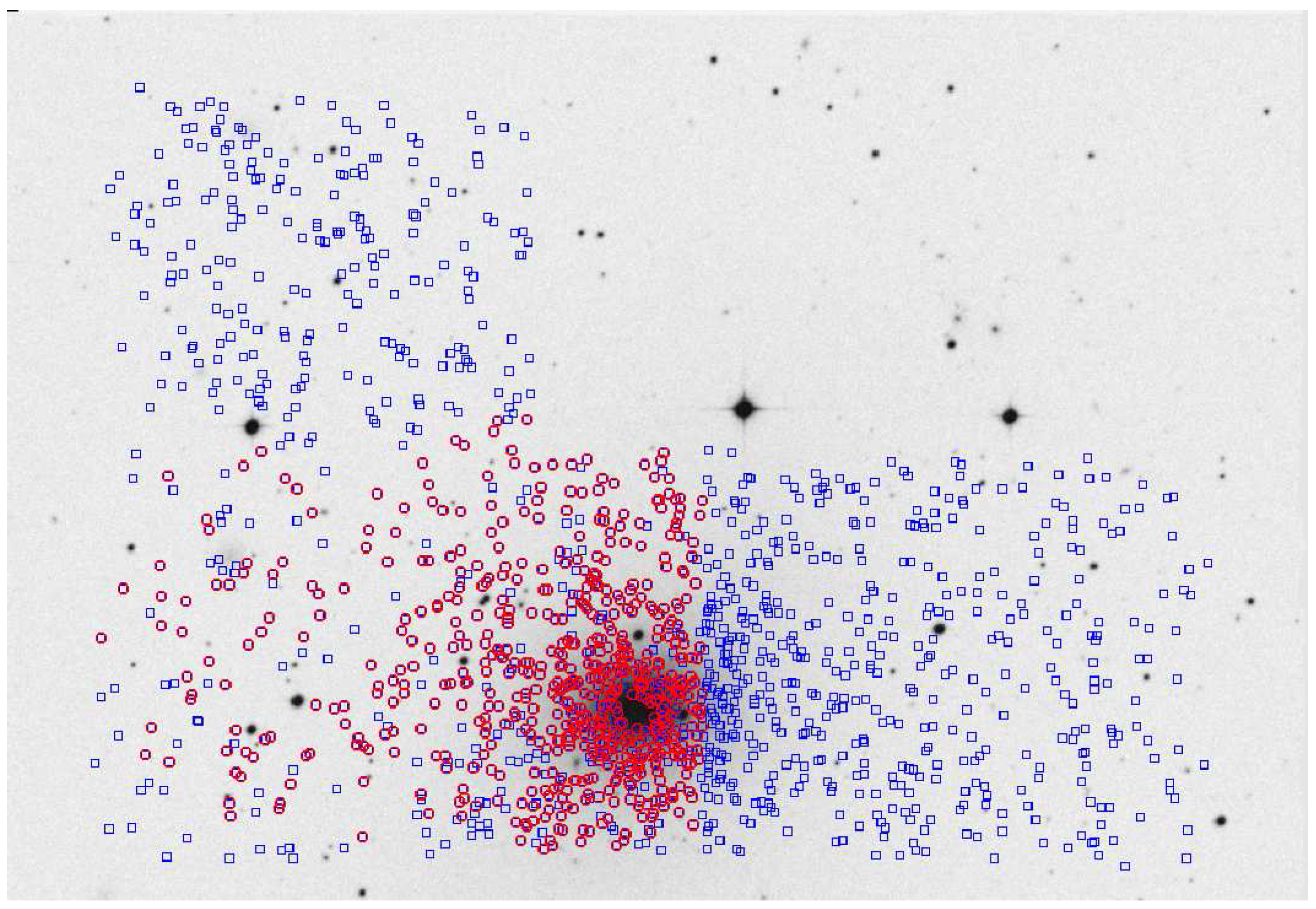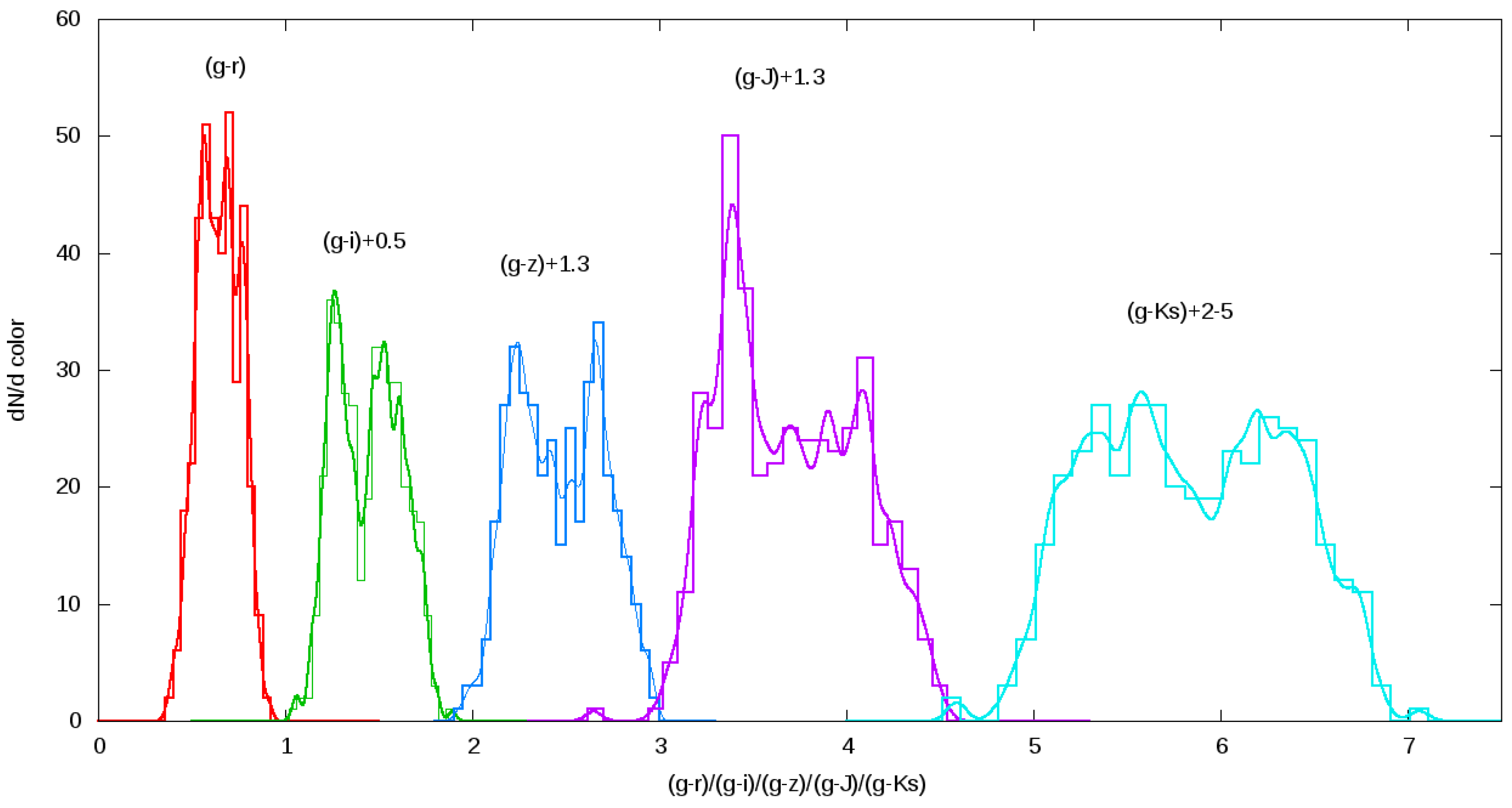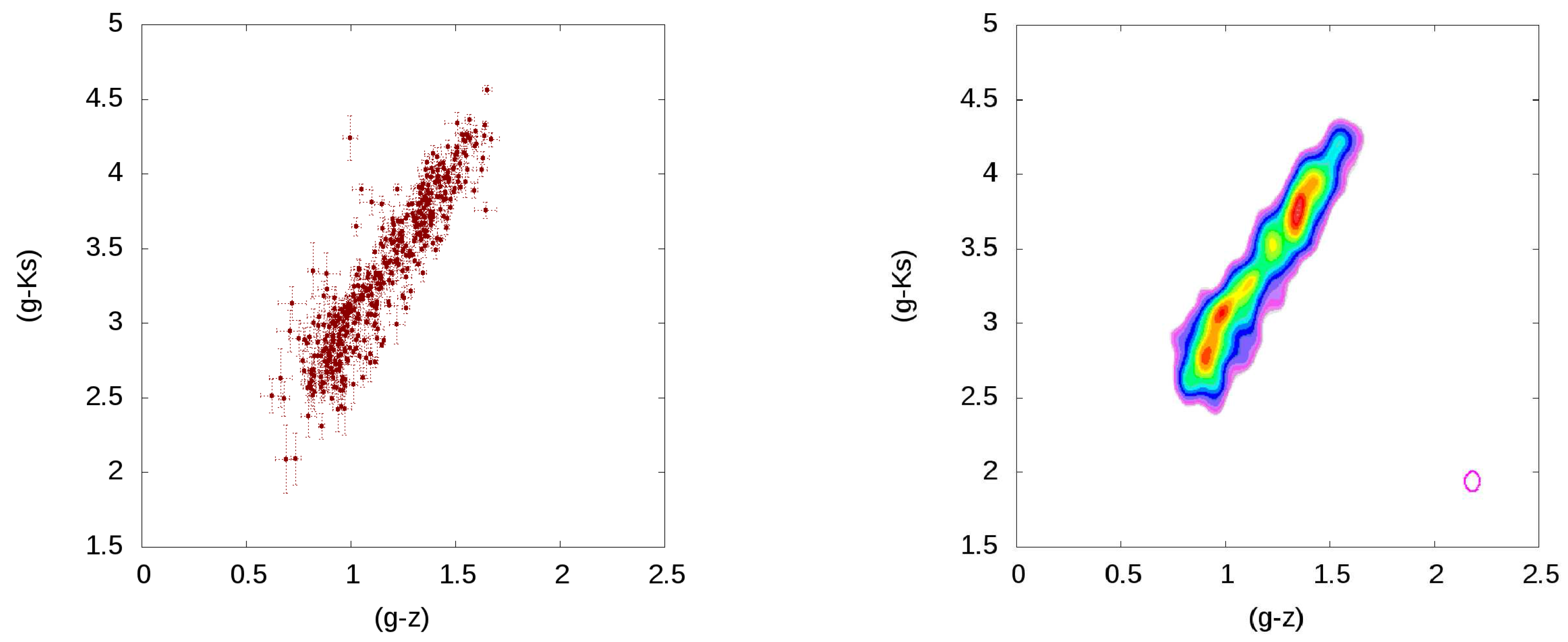The Brazil–Argentina Gemini Group for the Study of Globular Cluster Systems (BAGGs GCs): FLAMINGOS-2 and GMOS Data for NGC 1395
Abstract
1. Introduction
2. Data
3. Results
4. Discussion
Acknowledgments
Conflicts of Interest
References
- Brodie, J.; Strader, J. Extragalactic Globular Clusters and Galaxy Formation. Ann. Rev. Astron. Astrophys. 2006, 44, 193. [Google Scholar] [CrossRef]
- Ashman, K.; Zeph, S. Merging and Interacting Galaxies: Sites of Globular Cluster Formation; Astronomical Society of the Pacific: San Francisco, CA, USA, 1993; Volume 48, p. 776. [Google Scholar]
- Elson, R.; Santiago, B. The globular clusters in M87: A bimodal colour distribution. Mon. Not. R. Astron. Soc. 1996, 278, 617. [Google Scholar] [CrossRef]
- Barmby, P.; Huchra, J.P.; Brodie, J.P.; Forbes, D.A.; Schroder, L.L.; Grillmair, C.J. M31 Globular Clusters: Colors and Metallicities. Astron. J. 2000, 119, 727. [Google Scholar] [CrossRef]
- Sinnott, B.; Hou, A.; Anderson, R.; Harris, W.E.; Woodley, K.A. New g’r’i’z’ Photometry of the NGC 5128 Globular Cluster System. Astron. J. 2010, 140, 2101. [Google Scholar] [CrossRef]
- Forbes, D.A.; Brodie, J.P.; Grillmair, C.J. On the Origin of Globular Clusters in Elliptical and cD Galaxies. Astron. J. 1997, 113, 1652. [Google Scholar] [CrossRef]
- Forte, J.; Vega, E.; Faifer, F.; Smith Castelli, A.; Escudero, C.; González, N.; Sesto, L. Globular clusters: DNA of early-type galaxies? Mon. Not. R. Astron. Soc. 2014, 441, 1391. [Google Scholar] [CrossRef]
- Beasley, M.; Baugh, C.; Forbes, D.; Sharples, R.; Frenk, C. On the formation of globular cluster systems in a hierarchical Universe. Mon. Not. R. Astron. Soc. 2002, 333, 383. [Google Scholar] [CrossRef]
- Muratov, A.; Gnedin, O. Modeling the Metallicity Distribution of Globular Clusters. Astrophys. J. 2010, 718, 1266. [Google Scholar] [CrossRef]
- Li, H.; Gnedin, O.Y. Modeling the Formation of Globular Cluster Systems in the Virgo Cluster. Astrophys. J. 2014, 796, 10. [Google Scholar] [CrossRef]
- Richtler, T. Some remarks on extragalactic globular clusters. Bull. Astron. Soc. India 2006, 34, 83. [Google Scholar]
- Yoon, S.; Yi, S.; Lee, Y. Explaining the Color Distributions of Globular Cluster Systems in Elliptical Galaxies. Science 2006, 311, 1129. [Google Scholar] [CrossRef] [PubMed]
- Moyano Loyola, G.; Faifer, F.; Forte, J. Globular Clusters: Chemical Abundance—Integrated Colour calibration. Bol. Asoc. Argent. Astron. 2010, 53, 133. [Google Scholar]
- Usher, C.; Forbes, D.; Brodie, J.; Foster, C.; Spitler, L.; Arnold, J.; Romanowsky, A.; Strader, J.; Pota, V. The SLUGGS survey: Calcium triplet-based spectroscopic metallicities for over 900 globular clusters. Mon. Not. R. Astron. Soc. 2012, 426, 1475. [Google Scholar] [CrossRef]
- Cantiello, M.; Blakeslee, J.; Raimondo, G.; Chies-Santos, A.; Jennings, Z.; Norris, M.; Kuntschner, H. Globular clusters of NGC 3115 in the near-infrared. Demonstrating the correctness of two opposing scenarios. Astron. Astrophys. 2014, 564, L3. [Google Scholar] [CrossRef]
- Harris, W.; Ciccone, S.; Eadie, G.; Gnedin, O.; Geisler, D.; Rothberg, B.; Bailin, J. Globular Cluster Systems in Brightest Cluster Galaxies. III: Beyond Bimodality. Astrophys. J. 2017, 835, 101. [Google Scholar] [CrossRef]
- Worthey, G. Comprehensive stellar population models and the disentanglement of age and metallicity effects. Astrophys. J. Suppl. 1994, 95, 107. [Google Scholar] [CrossRef]
- Chies-Santos, A.; Larsen, S.; Cantiello, M.; Strader, J.; Kuntschner, H.; Wehner, E.M.; Brodie, J.P. An optical/NIR survey of globular clusters in early-type galaxies. III. On the colour bimodality of globular cluster systems. Astron. Astrophys. 2012, 539, 54. [Google Scholar] [CrossRef]
- Schirmer, M. THELI: Convenient Reduction of Optical, Near-infrared, and Mid-infrared Imaging Data. Astrophys. J. Suppl. 2013, 209, 21. [Google Scholar] [CrossRef]
- Stetson, P.B. DAOPHOT—A computer program for crowded-field stellar photometry. Publ. Astron. Soc. Pac. 1987, 99, 191. [Google Scholar] [CrossRef]
- Escudero, C.; Faifer, F.; Bassino, L.; Calderón, J.; Caso, J. The extremely populated globular cluster system of the lenticular galaxy NGC 6861. Mon. Not. R. Astron. Soc. 2015, 449, 612. [Google Scholar] [CrossRef]
- Bertin, E.; Arnouts, S. SExtractor: Software for source extraction. Astron. Astrophys. Suppl. 1996, 117, 393. [Google Scholar] [CrossRef]
- Faifer, F.; Forte, J.; Norris, M.; Bridges, T.; Forbes, D.; Zepf, S.; Beasley, M.; Gebhardt, K.; Hanes, D.; Sharples, R. Gemini/GMOS imaging of globular cluster systems in five early-type galaxies. Mon. Not. R. Astron. Soc. 2011, 416, 155. [Google Scholar] [CrossRef]
- Escudero, C.; Sesto, L.; González, N.; Faifer, F.; Smith Castelli, A.; Forte, J. Comparación fotométrica en imágenes Gemini/GMOS. Bol. Asoc. Argent. Astron. 2015, 57, 19. [Google Scholar]
- Cho, H.; Blakeslee, J.; Chies-Santos, A.; Jee, M.; Jensen, J.; Peng, E.; Lee, Y. The Globular Cluster System of the Coma cD Galaxy NGC 4874 from Hubble Space Telescope ACS and WFC3/IR Imaging. Astrophys. J. 2016, 822, 95. [Google Scholar] [CrossRef]
- Blakeslee, J.; Cho, H.; Peng, E.; Ferrarese, L.; Jordán, A.; Martel, A. Optical and Infrared Photometry of Globular Clusters in NGC 1399: Evidence for Color-Metallicity Nonlinearity. Astrophys. J. 2012, 746, 88. [Google Scholar] [CrossRef]
- Forte, J.; Faifer, F.; Vega, E.; Bassino, L.; Smith Castelli, A.; Cellone, S.; Geisler, D. Multicolour-metallicity relations from globular clusters in NGC 4486 (M87). Mon. Not. R. Astron. Soc. 2013, 431, 1405. [Google Scholar] [CrossRef]
- Powalka, M.; Lançon, A.; Puzia, T.H.; Peng, E.W.; Liu, C.; Muñoz, R.P.; Blakeslee, J.P.; Côté, P.; Ferrarese, L.; Roediger, J.; et al. The Next Generation Virgo Cluster Survey (NGVS). XXV. Fiducial Panchromatic Colors of Virgo Core Globular Clusters and Their Comparison to Model Predictions. Astrophys. J. Suppl. 2016, 227, 12. [Google Scholar] [CrossRef]
- Forte, J. Supra-galactic colour patterns in globular cluster systems. Mon. Not. R. Astron. Soc. 2017, 468, 3917. [Google Scholar] [CrossRef]



© 2017 by the authors. Licensee MDPI, Basel, Switzerland. This article is an open access article distributed under the terms and conditions of the Creative Commons Attribution (CC BY) license (http://creativecommons.org/licenses/by/4.0/).
Share and Cite
Faifer, F.; Escudero, C.; Smith Castelli, A.; Forte, J.; Sesto, L.; Chies Santos, A.; Cortesi, A.; Mendes de Oliveira, C. The Brazil–Argentina Gemini Group for the Study of Globular Cluster Systems (BAGGs GCs): FLAMINGOS-2 and GMOS Data for NGC 1395. Galaxies 2017, 5, 38. https://doi.org/10.3390/galaxies5030038
Faifer F, Escudero C, Smith Castelli A, Forte J, Sesto L, Chies Santos A, Cortesi A, Mendes de Oliveira C. The Brazil–Argentina Gemini Group for the Study of Globular Cluster Systems (BAGGs GCs): FLAMINGOS-2 and GMOS Data for NGC 1395. Galaxies. 2017; 5(3):38. https://doi.org/10.3390/galaxies5030038
Chicago/Turabian StyleFaifer, Favio, Carlos Escudero, Analía Smith Castelli, Juan Forte, Leandro Sesto, Ana Chies Santos, Arianna Cortesi, and Claudia Mendes de Oliveira. 2017. "The Brazil–Argentina Gemini Group for the Study of Globular Cluster Systems (BAGGs GCs): FLAMINGOS-2 and GMOS Data for NGC 1395" Galaxies 5, no. 3: 38. https://doi.org/10.3390/galaxies5030038
APA StyleFaifer, F., Escudero, C., Smith Castelli, A., Forte, J., Sesto, L., Chies Santos, A., Cortesi, A., & Mendes de Oliveira, C. (2017). The Brazil–Argentina Gemini Group for the Study of Globular Cluster Systems (BAGGs GCs): FLAMINGOS-2 and GMOS Data for NGC 1395. Galaxies, 5(3), 38. https://doi.org/10.3390/galaxies5030038




